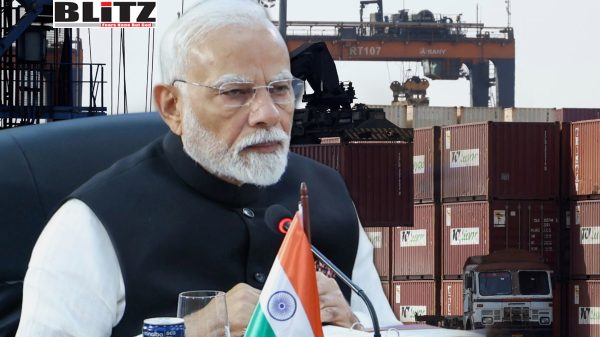Bangladesh’s global importance from economic and geopolitical perspective
- Update Time : Thursday, May 2, 2024

Back in 1972 – weeks after the independence of Bangladesh, then US Secretary of State Henry Kissinger compared the newly-born country as a “bottomless basket case”. Fifty-three years of its independence, Bangladesh now is amongst fastest growing economies in the world, while it has already become geopolitically extremely important to the world.
A middle power in the Indo-Pacific, Bangladesh is home to the sixth-most spoken language in the world, the third-largest Muslim-majority population in the world, and the second-largest economy in South Asia. Furthermore, Bangladesh, as the gateway to South and Southeast Asia, remains geographically central in the Bay of Bengal region. And naturally, the location of the country makes it a focal element in the Indo-Pacific strategy of the United States, India, Japan and Australia.
According to the World Bank, a robust demographic dividend, strong ready-made garment exports, resilient remittance inflows, and stable macroeconomic conditions have supported rapid economic growth over the past two decades.
The country’s GDP per capita was US$2,800 in 2022 – already higher than India’s. And at its current growth rate, Bangladesh is on track to become an upper-middle-income country (at least US$4,000 GDP per capita) by 2031.
As during the past fifteen years, Bangladesh has already been seen by the international community and economic experts as an ‘Economic Star’, people keep asking – why is Bangladesh developing so fast. According to analysts, the story of economic growth in Bangladesh has two main characters – ready-made garments (RMG) and remittance. Their contribution to the GDP in fiscal year 2023—10.35 percent by the RMG sector and 4.76 percent by remittance – shows that these sectors are vital cogs for the economy. But the picture of their pivotal role is better painted when these sectors’ contribution as foreign exchange earners is considered. RMG makes up an overwhelming 84.58 percent of Bangladesh’s total exports in FY23. Remittances made up 41.29 percent of export earnings and also contributed to 31.10 percent of import payments, indicating a net gain.
In the background is the steady contribution of the agricultural sector, which has made up 11.20 percent of the GDP in the most recently concluded fiscal year. Historically, especially in the last 20 years when Bangladesh has seen sustained growth, this contribution has slowly declined. This indicates a growth pattern in the economy that has slowly shifted towards industries over agriculture, and the data supports it as well, with contribution of industry (including construction) to GDP rising steadily during this time.
Bangladesh stands as a linchpin bridging South and Southeast Asia, its position in the Bay of Bengal making it pivotal in regional dynamics. This centrality aligns with the Indo-Pacific strategies of major powers like the US, China, India, Japan, and Australia. Diverse initiatives such as the Asia Rebalancing Strategy and the Belt and Road Initiative underscore the need to address evolving security, economic, and technological challenges in the region.
While the United States says, “Bangladesh is a strategically important country in South Asia and the Indo-Pacific region due to its geographic location connecting South and Southeast Asia”, according to the United Kingdom, “Bangladesh is an increasingly important strategic partner for the UK in the Indo-Pacific region and it is a key player in upholding the Rules-Based International System (RBIS)”. According to Japan, “Bangladesh, located in the Bay of Bengal, is a vital country in geopolitical terms and it needs to utilize its geographical advantage to increase economic opportunities fully”.
Commenting on Bangladesh’s geopolitical importance, C. Raja Mohan, visiting professor at the National University of Singapore’s Institute of South Asian Studies wrote in Foreign Policy, “Bangladesh’s geographic proximity to Nepal and Bhutan in the north, China in the northeast, and Burma in the southeast make it an attractive partner to all of them. For India, Bangladesh has in recent years emerged as its most important neighbor in the subcontinent—with strengthening strategic, political, and economic ties. Beyond its region, Dhaka is also a major contributor of forces for international peacekeeping”.
He further wrote, “Bangladesh’s special location and political character would not have amounted to much if the nation had not made itself an economic success. To understand the scale of Bangladesh’s economic transformation relative to Pakistan and India, let us consider two important facts.
“First, Bangladesh overtook Pakistan in 2019 to become the second-largest economy in the subcontinent – US$303 billion to US$279 billion in annual GDP. The gap between the two is likely to grow, with Bangladesh sustaining its growth momentum through the COVID-19 pandemic and Pakistan struggling to end its economic malaise…”
Pakistan Today in an article said:
The basic key factor behind the geopolitical importance of Bangladesh is its geography. The country shares land borders with Myanmar and India. Due to its geographical position, Bangladesh is a natural link between South Asia and Southeast Asia. The country is also a vital geopolitical ally to India, in that it has the potential to facilitate greater integration between Northeast India and Mainland India. Not only that, due to its open access to the Bay of Bengal, Bangladesh has become significant for both China and the USA.
Previously Bangladesh’s importance in South Asian geopolitics was largely defined by the Sino-Indian rivalry and the Indo-Pak conflict; as India, Pakistan and China all are in the close proximity of Bangladesh. But in the post-Cold War era, China’s growing ambition in the South Asian region and the Bay of Bengal has changed the equation of geopolitics for Bangladesh. China followed the combined theories of geopolitics for its expansion.
The “Sea Power” theory of Alfred Thayer Mahan from the USA, said those who controlled the sea would control the world; the “Heartland” theory of Halford John Mackinder from Britain said those who controlled Eurasia would control the world; while the “Rim Land” theory of Nicholas John Spykman from the USA said those who controlled the rim land would control the world. To control Eurasia, rimland and heartland, China needed to expand its connectivity with the outer world. But due to the rivalry with India, the opportunity of connectivity narrowed down and there came the geopolitical importance of Bangladesh.
Prime Minister Sheikh Hasina’s government maintains a non-aligned stance, distinct from Western approaches to the Indo-Pacific. While the West’s strategy often reflects anti-China sentiments, Bangladesh advocates an inclusive approach, emphasizing cooperation and stability. With a vision of a free and open Indo-Pacific, Bangladesh seeks peace and development for all neighboring nations.
Balancing relations with Western powers, Russia, China, and India, Sheikh Hasina prioritizes engagement with Middle Eastern countries. The recent visit of Sheikh Tamim bin Hamad Al Thani, the Emir of Qatar, marked a significant milestone, signifying enhanced cooperation between Bangladesh and Qatar through multiple Memoranda of Understanding.
Political stability and robust infrastructure development are driving foreign investment interest in Bangladesh, highlighting the nation’s attractiveness as an investment destination. Moreover, due to Bangladesh’s geopolitical importance, a large number of nations are eyeing on this country and expressing sincerest willingness of further strengthening relations with Dhaka through multiple ways.











